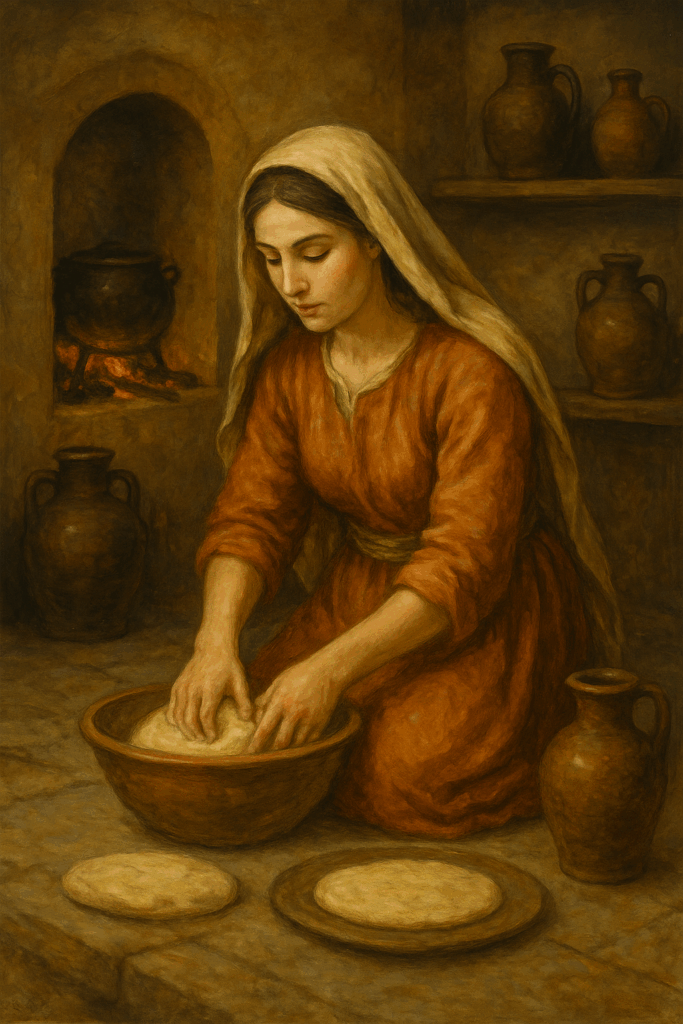
The Life of Sarah: Doubles & Echoes of Eden
The Torah opens Chayyei Sarah with an unusual phrase: vayihyu chayyei Sarah, “and the lives of Sarah were…” Her life is spoken of in the plural, hinting that her story is one of layers, repetitions, and echoes. The grammar suggests that Sarah’s life unfolds in cycles, that her story needs to be read more than once to be fully understood.
Sarah seems a kind of second or restored Eve reimagining Eve’s purpose as mother of the living. If Eve’s story begins in the garden and moves outward into exile, Sarah’s story begins in barrenness and moves toward a restored garden—the matriarch through whom Eden’s promise begins to be replanted in the land.
The theme of doubling is present even in the geography. Sarah dies in Kiryat Arba, “the city of four,”recalling the four rivers that flowed from Eden. She is buried in Hebron, whose name carries the meaning of joining, coupling, or binding. This is followed by Machpelah, the “doubled cave,” from kafal, meaning to fold or duplicate. According to rabbinic tradition, Machpelah had two chambers and was itself a doubled space.
The text describes Abraham’s purchase of the cave, the field, and all the trees within its boundaries in Edenic detail. The rabbis saw Machpelah as nothing less than the entrance to the Garden of Eden. Abraham, they said, caught the fragrance of Eden there—the lingering scent of a world before exile.
The purchase of Machpelah is a legal transaction. Abraham negotiates with Ephron the Hittite in the public gate where witnesses gather. The Hittites address Abraham as a nasi elohim, a prince of God, acknowledging his authority and sacred standing.
When the land is transferred to Abraham, it becomes the very first piece of the promised land legally possessed. The field, the cave, and the trees create a kind of micro-Eden—an earthly sanctuary awaiting the resurrection. Abraham is anchoring Israel’s future in holy ground.
Mamre: A Replanted Garden of Encounter
Machpelah lies beside Mamre, a place already steeped in divine encounters. Mamre means “fatness,” a symbol of abundance and divine favor, calling to mind the goodness of Eden. The terebinth and oak groves of the region were ancient symbols of sacred space and divine presence—natural sanctuaries in the world of the ancient Near East.
Here Abraham built an altar. Here God appeared to him. Here the three mysterious visitors shared a covenantal meal under the shade of ancient trees. Mamre becomes a restored meeting place between God and humanity, a garden moment where God’s divine presence rests among the trees.
The setting is saturated with Edenic imagery: shade, fellowship, blessing, abundance. Mamre is not Eden, but it resonates with Eden’s symbology, becoming a place where promise and presence converge.
Mamre sits on the Judean ridge near Hebron, one of the highest elevations in the region. Ancient tradition viewed mountains as cosmic pillars linking heaven and earth. Eden, too, was imagined as a mountain from which the rivers flowed downward into the world. Mamre thus becomes a proto-mountain sanctuary, The geography reinforces this theology: God meets Abraham in a place elevated above ordinary life, surrounded by trees, overlooking the land of promise. Mamre is a mountain-garden where heaven once more touches earth.
The Search for a Wife
The next event shifts to Abraham’s servant seeking a wife for Isaac. The story unfolds with emphasizing the ongoing theme of doubling. At the well, Eliezer prays for a sign. Rebekah appears and enacts the sign precisely, offering water to him and to the camels. Wells in Scripture represent life, abundance, and covenant blessing. Many biblical betrothals occur at wells, making them symbolic thresholds.
Rebekah becomes a renewed echo of Sarah, who herself was a renewed echo of Eve. When Isaac brings her into Sarah’s tent, he is comforted—an indication that Sarah’s legacy continues through Rebekah, and the matriarchal mantle passes from one Eve-figure to the next.
Isaac in the Field: The Return to Eden’s Prayer
Later, we find Isaac “meditating in the field” at the moment Rebekah arrives. The rabbis linked this to the same phrase, si’ach sadeh, in Genesis 2:5, a phrase connected with the shrubs of the field before the creation of man. They saw in it an early hint of prayer, contemplation, and divine presence.
Isaac’s field would become an idiom for the Temple—a sacred space where God and humanity meet. The sages also used “the King in the field” to describe the nearness of God during the month of Elul, awaiting His bride. Rebekah’s arrival in this moment becomes a restored Eden encounter, a reunion at the threshold between earth and heaven.
Abraham’s Death and Another Double Reunion
Abraham’s death at 175 is described using a wordplay to suggest completeness and satisfaction. His sons Isaac and Ishmael bury him together, another doubled scene of reconciliation and restoration.
Brothers once divided are now reunited at the entrance to Eden’s gate. The pattern is complete: the mother of covenant is first buried in a doubled cave, now the father of covenant is buried in the same place and the sons stand side by side in unity for the first time in years. The cycle of doubles concludes with reconciliation and peace.
A Replanted Eden at the Heart of the Promise
When all these threads are gathered together, Chayyei Sarah becomes more than a narrative of death or burial. It becomes a renewed story of Eden. The garden imagery: trees, mountains, wells, groves, altars, covenants flows through the text.
Machpelah is the seed for future resurrection. Mamre a meeting place for divine presence. Rebekah becomes the living continuation of Sarah’s promise. Isaac meditates in a field that is both Temple and Garden. Abraham secures a foothold in the land that will one day blossom with the fullness of Eden.
In this way, Chayyei Sarah is not the story of a life ending. It is the story of life doubling back, echoing forward, and rooting itself once again in the soil where God will walk again with His people in perfect intimacy. It is Eden in seed form, waiting for its resurrection.
In this Torah portion, the deaths of Sarah and Abraham become like bookends—two pillars framing a story of companionship, covenant, and restoration. Their lives were bound together, and their deaths are bound together as well. Between these bookends unfolds the betrothal of Isaac and Rebekah, a union that itself echoes Eden: the joining of man and woman, the renewal of life, the covenantal blessing that multiplies into generations. The rhythm of doubles—two lives, two deaths, two sons reunited, two wells, two matriarchs—and through them, the companionship that is meant to heal the fractures of exile.
This theme of pairing and union reaches back to the very first marriage in Genesis: “A man shall leave his father and mother and be joined to his wife, and the two shall become one flesh.” Eden’s joy is located not only in its trees and rivers but in covenantal union—fruitfulness, fellowship, life shared. This is why Yeshua speaks of Himself as the Bridegroom and His people as the Bride.
And yet the echoes of Eden do not erase the world we actually live in. This is in no way a judgment upon the divorced, the widowed, or the single. The Torah’s Edenic imagery is not restricted to biological unions; it is a picture of divine companionship. For those whose stories include loss, grief, or unexpected paths, Scripture offers a deeper truth: “Your Maker is your Husband.” The God who walked with Adam and Chavah in the garden walks with every soul who trusts Him. The richness, blessing, and fruitfulness of Eden are not limited to marriage but are gifts God gives to all who dwell with Him.


Leave a Reply